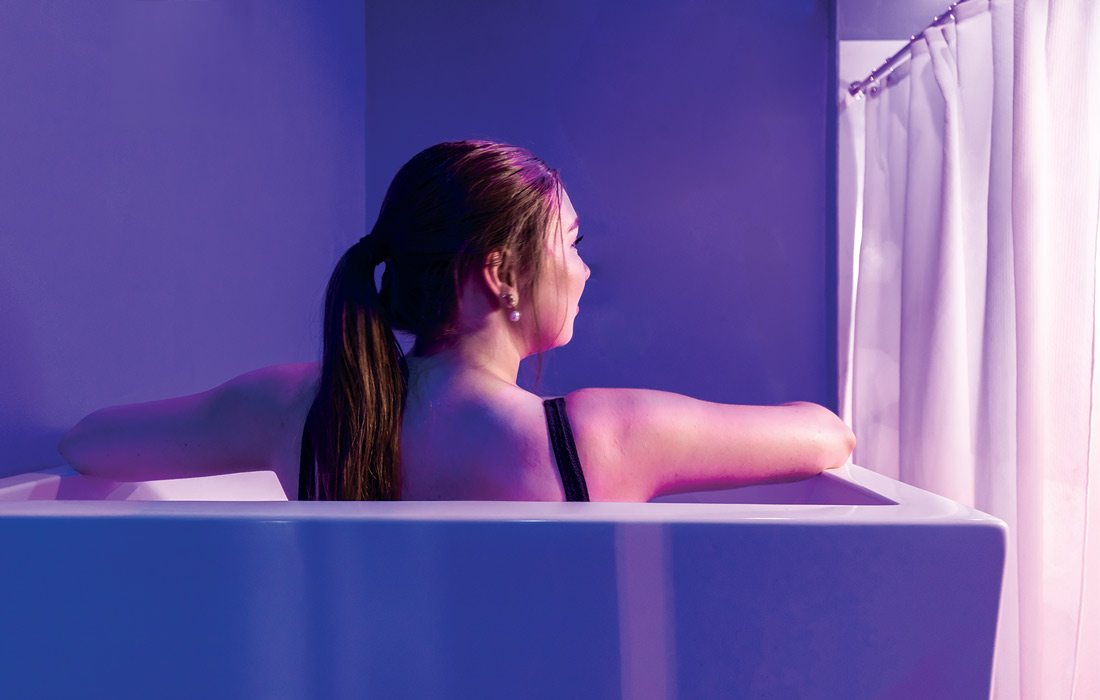
Lifestyle
We Tried Immersion Contrast Therapy at Theta Wellness
We headed to Theta Wellness Center to see what all the fuss was about for immersion contrast therapy.
By Jordan Blomquist
Sep 2024

On a recent Monday, I hadn’t expected to find myself face-to-face with a cold plunge—but there we were: me, 417 photographer Katy St. Clair and a Titan Cold Plunge Tub filled with, truly, the coldest water I had ever felt. I’d heard athletes and celebrities rave about the benefits of cold plunging, but it never appealed to me. The idea of becoming submerged in near-freezing water just didn’t sound relaxing. Recently, though, a practice called contrast therapy has been on the rise. It involves alternating between a cold plunge and a sauna in the same session. “Contrast therapy has become very mainstream with more research,” says Amber Shoemaker, manager at Theta Wellness Center (1339 E. Montclair St., Springfield). “[The cold plunge and sauna] both have very similar benefits, but it has been shown the contrasts boost all of those for you.”
There’s an ongoing debate about whether cold plunging benefits mental or physical health more—turns out it supports both. “It’s great for reducing inflammation and for physical, mental and psychological health,” she says. “It’s great for stress and anxiety, and depression as well.” According to Shoemaker, the practice resets the mitochondria on the surface of your skin, and the immune system benefits from the lymphatic work done in the cold plunge.
I decided to test out these benefits myself. I had been in a sauna before, but never a cold plunge. Like with anything that makes me uncomfortable, I did what I always do before going: spend hours scrolling “I wish I knew this before I went” articles and wondering how I tend to get myself into these situations. I learned a few things that helped, though. For starters, it’s going to be cold—really cold. In fact, Theta’s cold plunge sits at 48°F. I also learned that it takes people many tries before they can endure the cold for minutes at a time, so I made sure to give myself grace.
Walking into Theta was like walking into a wellness retreat in the heart of Springfield. The lights were dim, with ambiance lighting glowing in every corner of the spa. I immediately felt more comfortable walking into the lobby, which is their goal: to create an environment where customers feel safe. Before diving into my session, I chatted with Shoemaker, and she recommended I start with the cold plunge, then move to the sauna and finish with another plunge. “Give yourself about five minutes in between so that it is not a shock on your system and they can work together,” Shoemaker says. Conveniently, the Finnish sauna and cold plunge are in the same room, so I could use both during my session.
I stood over the tub convincing myself I had to take the plunge—how hard could it be, right? Wrong! While there are many physical benefits of the cold plunge to anticipate, I immediately experienced the mental and psychological challenges upon sinking into the piercingly cold water. There is something to be said about your mind telling you that you can’t do something, and then overcoming those thoughts and doing it anyway. I may not have been able to stay in as long as I did—which wasn’t that long, I should add—if Katy hadn’t been there to motivate and cheer me on. Thanks, Katy!
Getting in was just the tip of the iceberg. As soon as you find stillness, it gets unbearably cold. This being my first cold plunge, I couldn’t last the recommended minimum of three to five minutes. I now understand why it takes many people several attempts to build the mental toughness to endure that long. Luckily, Shoemaker encouraged me beforehand to be proud of myself if I made it at least 30 seconds—and that I did!
After my first round in the cold plunge, I waited the recommended five minutes before entering the Finnish sauna, which heats the room to temperatures between 150°F and 195°F. Stones are placed on the heater with a bowl of water nearby, so you can generate steam by tossing it on the sizzling hot stones. It felt like a science experiment to gently pour water on the stones and watch the steam rise. This added humidity, which was surprisingly more relaxing than a dry heat following the intense cold. The Finnish sauna’s steam and high heat are what separates it from a traditional infrared sauna. It is recommended to spend 12 to 20 minutes in the sauna to experience the benefits—and to rinse off before going back to the cold plunge.
I completed the session with one more cautiously optimistic dip in the cold plunge. Yep, still shockingly cold.
Experiencing the cold plunge and Finnish sauna on a Monday was the best thing I could do for myself. Typically, Mondays are difficult as I transition back to the week’s routine after the weekend. I tend to be more tired and make more frequent trips to the coffee machine as the day drags on. But on this Monday, I found myself more energized than ever.
If the long-term benefits ring true, I can see why people quickly become addicted to cold plunging. Will I? Only time will tell.












